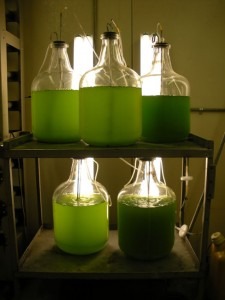Growing Algae – By: Dr. John Kyndt ( Head Scientist of the Renewable Energy Program at Advanced Energy Creations Lab) and Dr. Aecio D’Silva.

Growing algae is easy, right? Just let your swimming pool or pond sit for a couple of days with enough sunlight and some algae will start appearing. You will probably even get a decent amount of biomass out (more than what you want if you need to clean it out).
However, maintaining a healthy algal culture at its maximum productivity is not as straightforward as one initially expects. From a biochemical standpoint you actually do need a long list of chemicals (nutrients) to be optimized to keep your culture ‘happy’.
Besides having enough light and optimal temperature and pH, growing algae require carbon, nitrogen, phosphorus, potassium, calcium, iron, magnesium, and a long list of trace amounts of minerals in the water.
The three main nutrients for growing algae are essentially carbon (C), nitrogen (N), and phosphorous (P). For the most part there are enough of the other minerals present in the water that there is not much need for supplementation when the culture is started.
However once the culture is growing healthy and ‘blooming’ these other mineral metals need to be closely monitored and optimized as well.
Growing Algae: Less Input = Lower Cost
We generally have a gross idea of how much of the nutrients are required for growing algae, however if you ask most people in the field if they optimized their media for cost input versus biomass output you will find that most of them have not put forward the time and investment to fully analyze this.
Nevertheless this is a very important factor and can save a significant amount on fertilizer inputs on a large scale. Most people have analyzed the cost of their carbon input (e.g. from CO2), but there is for example an optimal N to P ratio that is species dependent which is often not considered.
Growing Algae: Recycle N and P: Necessity, not a Choice
When growing algae for oil production there is one important factor about nutrients to consider. The carbon is really what ends up in your product. The lipids are essentially composed of carbon, oxygen and hydrogen atoms.
The N and P are used in the synthesis of the machinery (proteins and DNA) that allows the algae to grow and synthesize the lipids, but they end up as part of the “left-over” biomass after extracting the lipids. Basically N and P can be seen as catalysts that can be recovered from the lipid extracted algae (LEA).
Theoretical calculations show that there is simply not enough fertilizer to grow algae (or other biofuel crops) as a fossil oil replacement if one doesn’t recycle the N and P. The recycling or reuse of the N and P has been promoted as a ‘natural’ part of the process of large scale algal cultivation by several groups, however it is often overlooked, underestimated or unknown that this will come with a certain cost.
Depending on your extraction process it is important to understand what chemical form your N and P end up in, and if this is a form that can be directly reused by the algae, or is there need for a ‘conversion’ step.
Wastewater is a good source of free nutrients for algae cultivation that can significantly reduce the operation cost of growing algae systems. One caution with wastewater is the presence of organic substrates which could lead to higher risk of contamination of the algae by heterotrophic bacteria.
As we posted before, depending on the wastewater source, there may also be a need for an alternative primary cleanup step, which will need to feed into the overall life cycle analysis.
Growing Algae: Lessons from Nature
Nutrient recycling is not a new concept. In natural ecosystems all nutrients are essentially recycled in what is known as a biogeochemical cycle. The chemicals are recycled, although in some cycles there may be places (called reservoirs) where they may reside for years before they are reused. Often this is the time it takes for a natural conversion to a usable chemical form.
The key factor in these processes is time. The algae biofuels industry needs to come up with clever, green, sustainable ways speed up this recycling process.
One way, is to use Aquafuelsponics systems to apply what we’ve learned from nature and optimize the nutrient recycling process in an intelligent design that makes it biochemically feasible to reuse the N and P directly in the algae cultivation systems.
AquaFuelsPonics = Aquaculture + Biofuels + Hydroponics
Systems AquaFuelsPonics or just FuelsPonics allows you grow healthy food and biofuels feedstock. It is the synergetic integration of the production of fish (normally tilapia), bio-fertilizer, hydroponic plants (vegetables and other produce), biogas and algae for biofuels (large-scale systems) in a controlled environment where the water is continuously recycled and re-circulated.
This is an approach that could help algae for biofuels growers look at the overall picture and think outside the box for a sustainable solution. However, some refining and test pilot work needs to be done before utilizing these and other current approaches on a massive scale.
Related Links:



[…] Source: https://algaeforbiofuels.com/growing-algae-nutrient-optimization/ […]